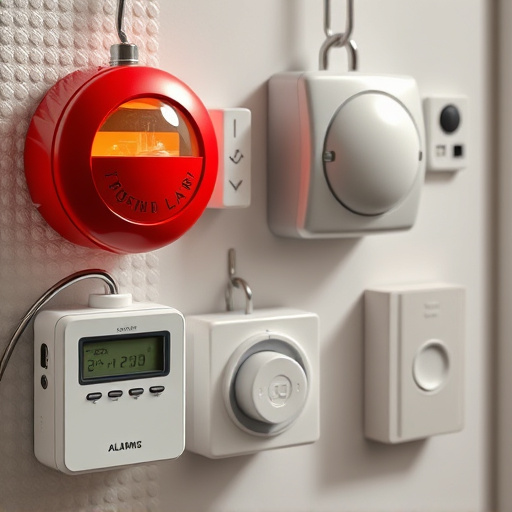Lone workers face safety challenges due to lack of immediate backup. The Emergency Panic Alarm Keychain Device mitigates these risks by enabling quick alerts to authorities via a single press, ensuring prompt response times and enhanced safety in isolated or high-risk environments. This compact, accessible device features loud sirens and GPS tracking for faster assistance, providing peace of mind through continuous monitoring. Strategic training and seamless hardware integration are crucial for effective deployment, fostering a safety-conscious culture that empowers lone workers to protect themselves.
In today’s digital era, ensuring the safety of lone workers is paramount. With increasing remote work and independent operations, understanding and mitigating risks become crucial. This article explores comprehensive safety alert systems for lone workers, focusing on key components like emergency panic alarms and portable keychain devices. We delve into implementation strategies, training, and advanced security measures to foster a robust safety net for those working alone. By harnessing these tools, organizations can enhance response times and peace of mind.
- Understanding Lone Worker Risks
- The Role of Emergency Panic Alarms
- Keychain Devices: Portable Safety
- Implementation and Training Strategies
- Enhancing Solo Worker Security Measures
Understanding Lone Worker Risks
Lone workers, by definition, operate independently without immediate supervision or support from colleagues. While this autonomy offers numerous benefits in terms of efficiency and innovation, it also presents unique safety challenges. These individuals may encounter hazardous situations that require prompt attention and assistance due to a lack of immediate backup. Understanding these risks is paramount in developing effective solutions for lone worker safety.
One of the primary concerns is the delay in accessing help during emergencies. With no one nearby to assist or alert others, a lone worker might struggle to get immediate response times when facing an unforeseen incident, such as an accident, medical emergency, or hostile situation. An Emergency Panic Alarm Keychain Device can play a pivotal role in mitigating these risks by allowing workers to quickly trigger an alert and notify relevant authorities or emergency services with just a press of a button.
The Role of Emergency Panic Alarms
In the event of an emergency, especially for lone workers operating in isolated or high-risk environments, the role of an Emergency Panic Alarm Keychain Device cannot be overstated. This compact yet powerful tool serves as a lifeline, allowing users to instantly alert others for assistance with just a quick press. The device’s loud siren and GPS tracking capabilities ensure that help can be dispatched swiftly, providing peace of mind and enhancing safety measures.
Keychain-sized Emergency Panic Alarms are designed to be easily accessible and discreetly worn, enabling workers to activate them in critical situations without delay. This technology has revolutionized personal safety, particularly for individuals working alone, by offering an immediate response mechanism that can prevent potential tragedies.
Keychain Devices: Portable Safety
Lone workers often find themselves in situations where immediate assistance is crucial. Portable safety devices, such as emergency panic alarm keychain devices, have emerged as invaluable tools to enhance their well-being. These compact and lightweight gadgets are designed to be easily accessible, allowing users to quickly trigger an alert in case of an emergency. With a simple press or pull of a tab, the device emits a loud siren, which can attract attention and signal for help from nearby individuals or emergency services.
Keychain devices offer a discreet yet powerful solution, ensuring lone workers remain visible and protected. Their compact nature makes them convenient to carry on keys, in pockets, or even attached to clothing, providing peace of mind. Moreover, these devices often include GPS tracking capabilities, enabling the monitoring of a worker’s location, which can be vital for swift response times and rescue operations.
Implementation and Training Strategies
The successful implementation of safety alert systems for lone workers hinges on strategic training and integration. Organizations should begin by equipping their employees with simple yet effective tools like an Emergency Panic Alarm Keychain Device, ensuring it’s intuitive and easily accessible. Training sessions should focus on scenario-based learning, teaching workers how to recognize potential hazards and respond promptly using the device.
Regular drills and simulations are crucial to reinforce readiness. Management must also promote an open dialogue, encouraging workers to share concerns and suggest improvements. By combining these training strategies with robust hardware, companies can create a culture of safety awareness, empowering lone workers to protect themselves effectively in various situations.
Enhancing Solo Worker Security Measures
In today’s digital era, enhancing solo worker security measures has become paramount. One innovative solution gaining traction is the use of an emergency panic alarm keychain device. This compact and discreet tool empowers workers operating alone to swiftly request assistance in case of emergencies. With just a quick press of a button, a loud alarm is triggered, alerting nearby individuals or emergency services via GPS coordinates, ensuring prompt response times.
These devices offer more than just an alarm; they often incorporate features like real-time tracking and automatic fall detection, providing peace of mind for both workers and their employers. By integrating such technology into daily routines, we can create a safer working environment, especially for those who frequently operate in remote or isolated areas.
Lone workers face unique challenges, making it imperative to implement robust safety measures. By understanding the risks specific to this demographic, organizations can significantly enhance their security. The article has explored essential tools like emergency panic alarms and portable keychain devices as vital components of a comprehensive safety strategy. These solutions empower individuals working alone by providing quick access to assistance during emergencies. As seen, a combination of well-designed implementation plans and adequate training is crucial for maximizing the benefits of these systems, ultimately fostering a safer work environment for solo workers.
